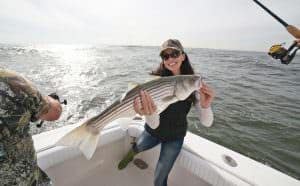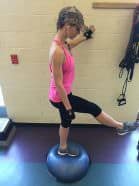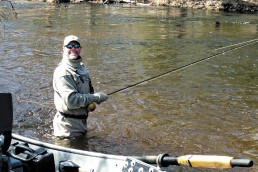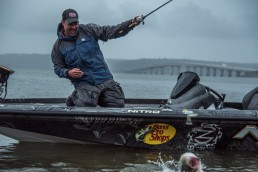Getting Stronger for Better Fishing
SHARE THIS POST
As temperatures begin to rise, we can probably all relate to the animals that are just coming out from their winter hiding places. If you’re an ice fisherman, then this certainly won’t be anything to celebrate. But for many of us, these warmer temperatures signify the start of springtime outdoor adventures.
Snowmelt often raises water levels, which in turn creates fantastic fishing opportunities. One of our favorite adventures to plan for this time of the year is a hike-in fishing trip. Not only does it add an element of adventure when compared to just driving up to the water’s edge, but it also creates a fantastic opportunity to explore new areas and get some added outdoor therapy.
Here are some tips for creating a weekend hiking and fishing adventure the whole family can enjoy:
- Plan ahead. Just a few Google searches can turn up a wealth of knowledge for any area you’re interested in exploring. Be sure to map out your course, stay on well-documented trails and be prepared with food and first-aid kits. A few minutes of preparation can ensure that you have a great time without worrying that something will go wrong.
- Know your limits. Most online sources for hiking trails or public fishing areas will have detailed maps and length descriptions of the trails. If the hike in to a great fishing spot is three miles, prepare accordingly for that. You don’t want to get stuck out there overnight if you’re unprepared, and, you don’t want to overdo it if you aren’t used to hiking that far. Also, be sure you tell somebody your exact plan and where you will be hiking or fishing in case of emergency.
- Get in shape before hitting the trails. Even though the winter months make it more difficult to get outside to exercise, you have plenty of opportunities to stay in shape in other ways. Playing in the snow with your kids is great cardiovascular exercise, and so is shoveling it. If you choose an activity every day that challenges you physically, you’ll be in good enough shape to take on the hiking trails when the weather warms up.
Fitness for fishing?
Some people might not associate fishing with fitness, but one directly affects the other. For example, we went on a fly-in fishing adventure to a lodge in Newfoundland/Labrador about two years ago. The place, Riverkeep Lodge, is an absolute fishing paradise. The Atikonak River passes through the area and holds five species of fish. We were told when we arrived—after the floatplane dropped us and our supplies off for the week—that we should be careful with our health, because the plane probably couldn’t come back even if we were to be injured. Wading through fast-moving currents has never carried such potential repercussions! Thankfully, we all had sure footing and made it through the week without injury. But there were plenty of times when I wondered what it would be like if something bad were to happen. Just thinking of those situations is what keeps me motivated to prepare ahead of time by staying as fit as possible.
Even if you want an adventure that’s slightly less dangerous or exotic than a fly-in, backcountry trip, you might still want to put some time in to be sure you get the most from your time on the water.
Here are some ideas for determining your ideal level of fitness, based on your fishing goals:
- If you want to fish calm waters from shore or from a boat, you may just need average balance and a normal, healthy body. In other words, a moderately healthy individual who is able to stand, sit and walk can achieve this.
- If you want to hike into an area to fish moderate waters (wading), and then hike back out, you will need average or above-average health ranges. If you have trouble balancing or walking, then this may not be a good idea for you until you feel capable of walking long distances on uneven surfaces. Try working on your balance by standing on one foot at a time, then switching, for long periods of time. The muscles in your legs and your core will develop and strengthen over time. This is especially important for wading in fast-moving waters or hiking through rough country. As you strengthen and develop balance, begin adding cardiovascular exercise to your daily routine.
- If your goal is to go deep-sea fishing, sport fishing, or for big game, then you will need to be sure that your body is ready for it. Not only will the boat be moving with the ocean waves, which requires balance, but you’ll also need to have a strong back, arms, shoulders and legs to reel the big fish in. For these adventures, I recommend weight training months in advance to build muscle, and then stretching and warming up your muscles prior to fishing, to prevent injury.
No matter what your fishing goals are, there is something out there for everyone. I truly believe that there is a type of fishing for every type of person, and it can be therapeutic to spend time on the water.
Knowing your limitations and setting goals will be the most crucial part of your planning strategy.
I’ve come up with a “Fitness for Fishing” regimen for anyone who wants to start preparing for an upcoming trip. See the details below, and find me on social media if you have any questions.
Are you enjoying this post?
You can be among the first to get the latest info on where to go, what to use and how to use it!
A Stronger Body for Better Fishing: Julie McQueen’s Workout
Bicep Curls: This popular exercise will strengthen your biceps—hence the name—and help prevent injury when you lift a fish from the water. By using your upper arm strength instead of your back, you will keep from pulling muscles and potentially causing injury.
How to do them: Hold one weight in each hand, with your arms down at your sides. Slowly bring one weight up at a time up by bending your elbow and contracting your bicep muscle. At the top, squeeze the weight and hold for a second before slowly retracting the bicep muscle and lowering the weight back to the starting point in a fluid movement. Choose a weight that enables you to do between 8 to 10 reps, and that challenges you during the final few reps. Switch arms after each set.
There are many variations of bicep curls, so experiment with different techniques!
Bodyweight-Angled Pull-ups: This exercise will not only sculpt your shoulder and back muscles, but it will also help you when you go to lift a cooler, tackle box or giant fish on the side of a boat. The shoulders and back connect many crucial muscle groups, and I highly recommend working on them once a week in this way. This exercise replicates the movements that we use in the field when lifting, pulling or working in a particularly heavy fish.
How to do them: Find either exercise straps that are meant to hold your body weight (pictured) or a secure metal bar to hold onto that is at chest height. Walk your feet in so that when you hold on and extend your arms, your body is at a steep angle to the floor. With feet shoulder-width apart, slowly pull your bodyweight up until your hands are at your shoulders. Hold this position for a second, then slowly retract your back and shoulder muscles until your arms are extended. Do 10 to 15 reps, and if it feels too easy, adjust your feet so your body is at a more extreme angle, which will increase the difficulty.
Unstable Platform Leg Circles: To simulate the feeling of being on a boat that is rocking with the waves, find a BOSU platform ball. Stand near a wall or something you can hold onto, and then lift one leg. You’ll notice that balancing on an unstable surface, like half of a ball, will use muscles you probably didn’t know you had. I like to lift one leg and move it around in small circles in front of me while focusing on my balance.
How to do them: Secure a BOSU balance ball in an area where you can hold onto something stable (a wall) if you need to. Stand on the top center of the ball and slowly lift one foot up in the air in front of you. When you have your balance, begin moving your lifted foot in small circles. Complete 10 circles, then switch feet. If you need to hold on at first, try to work on slowly gaining balance and completing the exercise without holding on. During this exercise, focus on maintaining small movements and contracting the small leg and core muscles that keep you standing upright when your balance is challenged.
Send Julie McQueen your outdoors-specific exercise and nutrition questions, at any of our social media pages. Like us at: facebook.com/MidWestOutdoorsTV, facebook.com/JulieMcQueen.brotherhood, and follow our Instagram feeds @mwoutdoor and @julesmcqueen. “Fitness for the Field” is peer-reviewed by trainers and nutritionists at UpLift Guided Fitness in Woodbury, Minn. Eat healthy for the rest of your outdoor-loving life at upliftfitness.com/21dayoffer.
MWO
SHARE THIS POST
Did you enjoy this post?
You can be among the first to get the latest info on where to go, what to use and how to use it!
Julie McQueen
Send Julie McQueen your outdoors-specific exercise and nutrition questions, at any of our social media pages. Like us at facebook.com/MidWestOutdoorsTV, facebook.com/JulieMcQueen.brotherhood, and follow our Instagram feeds @mwoutdoor and @julesmcqueen. “Fitness for the Field” is peer-reviewed by trainers and nutritionists at UpLift Guided Fitness in Woodbury, Minn. Eat healthy for the rest of your outdoor-loving life at upliftfitness.com/21dayoffer.



